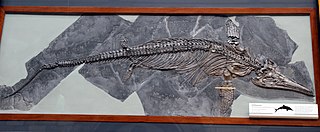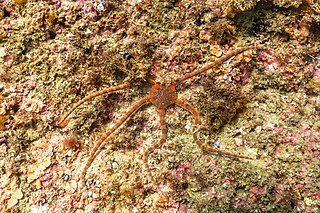
Sir Philip de Malpas Grey Egerton, 10th Baronet FRS was an English palaeontologist and Conservative politician from the Egerton family. He sat in the House of Commons variously between 1830 and his death in 1881.

Ichthyosaurus is a genus of ichthyosaurs from the Early Jurassic of Europe. Some specimens of the ichthyosaurid Protoichthyosaurus from England and Switzerland have been erroneously referred to this genus in the past. It is among the best known ichthyosaur genera, as it is the type genus of the order Ichthyosauria.

Termatosaurus is a potentially dubious genus of archosaur known from several tooth specimens. Its remains come from the Upper Triassic of France, England, Germany and Switzerland. Termatosaurus was once thought to have survived until the Early Jurassic, but the attributed Jurassic remains were redescribed as plesiosaur material. Two species are known of this animal: the type species, T. albertii, named by Meyer and T. Plieninger in 1844, and T. crocodilinus, by Quenstedt (1858).

Stenopterygius is an extinct genus of thunnosaur ichthyosaur known from Europe.

Leptonectes is a genus of ichthyosaur that lived in the Late Triassic to Early Jurassic. Fossils have been found in Belgium, Germany, Spain and the United Kingdom. A possible specimen from Switzerland first reported in 2006, has been reclassified as that of Hauffiopteryx. The type species, L. tenuirostris, reached 4 metres (13 ft) long, while L. moorei reached 3 metres (9.8 ft) long; the largest species, L. solei, was approximately 5–6 metres (16–20 ft) long.

The Posidonia Shale geologically known as the Sachrang Formation, is an Early Jurassic geological formation of southwestern and northeast Germany, northern Switzerland, northwestern Austria, southern Luxembourg and the Netherlands, including exceptionally well-preserved complete skeletons of fossil marine fish and reptiles.

Ophioderma is a genus of brittle stars in the family Ophiodermatidae.

Ophiopetra is a genus of prehistoric brittle stars. It lived in lagoons in Solnhofen Plattenkalk Formation. It has only one known species, Ophiopetra lithographica.

The Charmouth Mudstone Formation is a geological formation in England, dating to the Early Jurassic (Sinemurian–Pliensbachian). It forms part of the lower Lias Group. It is most prominently exposed at its type locality in cliff section between Lyme Regis and Charmouth but onshore it extends northwards to Market Weighton, Yorkshire, and in the subsurface of the East Midlands Shelf and Wessex Basin. The formation is notable for its fossils, including those of ammonites and marine reptiles and rare dinosaur remains. The formation played a prominent role in the history of early paleontology, with its Lyme Regis-Charmouth exposure being frequented by fossil collectors including Mary Anning.
The Allgäu Formation is a geologic formation in Austria, Germany and Slovakia. It preserves fossils dating back to the Hettangian to Sinemurian stages of the Early Jurassic period, or Raricostatum to Obtusum in the regional stratigraphy. Initially and formally defined by Jacobshagen (1965). The Allgäu Formation is formerly known as spotted marls (Lias-Fleckenmergel) and spotted marly limestones (Fleckenkalk). The formation is represented by dark-grey bioturbated limestones and marlstone interbeds. It represents basinal hemipelagic facies common in Alpine Tethys regions of Alps, Carpathians and other mountain ranges. Several horizons of the formation are particularly rich in ammonite fauna.
Neolioceratoides is genus of ammonites that lived during the Pliensbachian and Toarcian stages of early Jurassic. It has been considered to be a synonym of Lioceratoides, but cladistic analysis has shown, that this genus is not only valid, but they even belong to different subfamily, as Lioceratoides belongs to Harpoceratinae. Their fossils were found in Europe and northern Africa.

Ohmdenia is an extinct genus of prehistoric bony fish that lived from the Toarcian stage of the Early Jurassic period. Ohmdenia was first described in 1953 by Bernhard Hauff, based on a fossil found in the well-known Posidonia Shale in Holzmaden, Germany. For a long time this animal has been considered a close relative of Birgeria, a great predator typical of the Triassic period with an uncertain systematic position. Further studies have shown similarities with the Pachycormiformes, a group considered close to the origin of teleosts and also including giant forms and planktives. Some studies have erroneously indicated Ohmdenia as a synonym of Saurostomus, other studies have instead placed Ohmdenia as an important evolutionary passage between the basal pachicormiforms and the more derived planktivore pachicormiformes.
Paleontology or palaeontology is the study of prehistoric life forms on Earth through the examination of plant and animal fossils. This includes the study of body fossils, tracks (ichnites), burrows, cast-off parts, fossilised feces (coprolites), palynomorphs and chemical residues. Because humans have encountered fossils for millennia, paleontology has a long history both before and after becoming formalized as a science. This article records significant discoveries and events related to paleontology that occurred or were published in the year 2018.
The Klettgau Formation is a geological formation in Switzerland. It is Late Triassic in age, covering most of the mid to late Norian, the Carnian, and into the Rhaetian, spanning a period of 26-30 million years.

The Sachrang Formation or "Posidonienschiefer" Formation is a geological formation of southwestern Germany, northern Switzerland, northwestern Austria, southeast Luxembourg and the Netherlands, that spans about 3 million years during the Early Jurassic period. It is known for its detailed fossils, especially sea fauna, listed below. Composed mostly by black shale, the formation is a Lagerstätte, where fossils show exceptional preservation, with a thickness that varies from about 1 m to about 40 m on the Rhine level, being on the main quarry at Holzmaden between 5 and 14 m. Some of the preserved material has been transformed into fossil hydrocarbon Jet, specially wood remains, used for jewelry. The exceptional preservation seen on the Posidonia Shale has been studied since the late 1800s, finding that a cocktail of chemical and environmental factors let to such an impressive conservation of the marine fauna. The most common theory is the changes in the oxygen level, where the different anoxic events of the Toarcian left oxygen-depleted bottom waters, with the biota dying and falling to the bottom without any predator able to eat the dead bodies.

The Ciechocinek Formation is a Jurassic geologic formation which extends across the Baltic coast from Grimmen, Germany, to Nida, Lithuania, with its major sequence in Poland and boreholes in Kaliningrad. Dinosaur species uncovered here, including Emausaurus and other unclassified genus.

The Saubach Formation is a geological formation in Austria and Germany, dating to about 180–174 million years ago. It was described originally as Saubachschichten in 1975, and classified as part of the Lower Jurassic Adnet Group.

The Staffelegg Formation is a formation of Early Jurassic age in the Canton of Aargau of northern Switzerland. The siltstones, marls, limestones and intermittent sandstones of the formation were deposited on the Northern Tethyan Carbonate Platform (NTCP). The Staffelegg Formation has provided fossils of the ichthyosaur Eurhinosaurus longirostris and the ammonite Catacoeloceras raquinianum.
Rhomphaiodon is an extinct genus of prehistoric sharks in the order Synechodontiformes that has been found in Late Triassic and Early Jurassic deposits located in Europe. The type species R. minor was originally named as a species of Hybodus in 1837 by Louis Agassiz. A second species, R. nicolensis, was added when the genus was named in 1993.
















